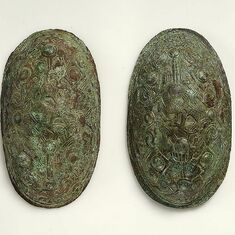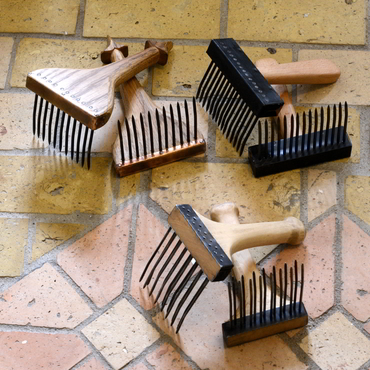Finding sufficiently dated graves
Finding a comprehensive list of datings for the Birka graves - this proved to be much more difficult than I thought and I didn't really find one. I would have expected some dating in Arbman's Birka I, some direkt answer as to whether a grave was dated to the 9th or the 10th century (preferably even somewhat more exact), but this seems not to be the case. I found datings of this kind in Geijer's Birka III, but since she only looked at some graves with textile remains, the picture remains incomplete. I wasn't able to include graves from "our" dating without textile remains. But at least I got some.
Deciding on a date
Deciding on a date for the artifacts - that's always a problem, no matter what artifact you're looking at. Did the buried person wear the jewelry given as grave goods during her lifetime, or has she been buried with the latest fashion? Did women change their pair of oval brooches when a new trend kicked in, or were they ever faithful to their old pair because they had been given them on a special occasion, like for example their wedding? If I was, say, in my late 20's and lived in the year 900, I might have died in the early to mid 10th century. If I took to the grave the one pair of brooches I always wore during my lifetime, it would have been something like the type P 51 (which was very common in Birka graves dated to the 10th century) and consequently, I would wear it now. But if people would have been buried with the latest fashion, I would have worn something else during my lifetime, namely those brooch types that were found in graves dated to around 900. To be honest, I have no clue which of the two options would be correct. What influences my choice in the end is something which would have influenced the women in the Viking Age as well (apart from fashion) and that is personal taste. I don't like the later brooches very much, so I opt for the earlier types.
So which brooch types are relevant?
Having decided on this, let's see which datings would be appropriate. All information on oval brooches in this blog post I took from Ingmar Jansson's work from 1985 (Jansson, Ingmar. Ovala spännbucklor: en studie av vikingatida standardsmycken med utgångspunkt från Björkö-fynden. I. Jansson, 1985).
If I lived in the year 900, being in my late 20's, I would have been born in the late 9th century and some of it might have influenced me when I grew to adulthood. I dismissed graves dated to the early 9th century, since this would have been the time of my grandmother or even grand-grandmother. Some graves were dated to "9th century" only and I looked at those since this could mean "later 9th" as well, I think. There are four oval brooch types from graves dated to this period: The Vendel / transitional type (clearly too early), P 27 A, Borre P 47 and five subtypes of P 37. Looking into the mid 9th century (when my mother would have been a young woman), there is a grave with type P 27 B. For graves dated to around 900, there are five graves with type P 42 and one with P 37. Let's look at the latter two.
Brooch types P 37 and P 42
P 37 was the most common brooch type from the early period, but there are a couple of finds from the later period as well. Clay moulds show that it was manufactured on Gotland, but also in Birka. Brooches of this type where found in other parts of Viking Age Sweden as well as Norway. There are several different variants, but the overall structure and decoration is the same. They were made in one piece, cast in bronze, often gilded, with a rhomboid grid dividing it into several fields with gripping beast decoration. Nine buttons of white metal could be mounted on each brooch, but those are not preserved on all finds.
P 42 brooches are (almost) always made of two pieces, the upper one is gilded and has rich openwork decorations. The lower piece is covered entirely by the upper one. The decoration is very similar to P 37, rhomboid grid, buttons and all. Of all the P 42 finds known until the mid 1980's, 2/3 are from Norway and 1/3 from Sweden. The combination with other brooch types in the graves containing P 42 suggest that it belonged more to the Later Birka Period, but other factors place it closer to the Earlier Birka Period, making it a sort of transitional type between the two. The brooches display the work of very good craftsmen and the people wearing them probably belonged to the highest social strata of their time. P 42 brooches are mostly distributed over the grave field Norr om Borg. Brooches of this type were found in other parts of Viking Age Sweden, only a few come from Norway.
The decision
P 42 seems to be quite typical for the time around AD 900, but I like to be a little bit old-fashioned, so P 37 seems just right for me. And this wouldn't be "wrong" since there are finds from around 900 of P 37 brooches. The gilded, openwork upper pieces of the P 42 types feel like a little bit too much, to be honest. So I am going to choose a fine pair of P 37 brooches which would still have been a beautiful eye catcher, if one considers how nice polished bronze with white metal buttons can look like, and which would have been quite common in early Viking Age Birka.








